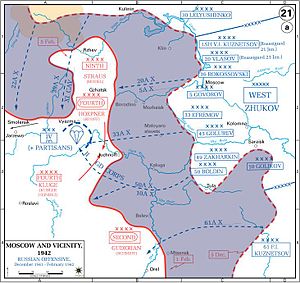Battles of Rzhev
| Rzhev Battles | |||||||
|---|---|---|---|---|---|---|---|
| Part of the Eastern Front of World War II | |||||||
 |
|||||||
|
|||||||
| Belligerents | |||||||
|
|
|
||||||
| Commanders and leaders | |||||||
|
|
|
||||||
| Strength | |||||||
|
Total: 2,100,000 Initial: 668,000 men 2,000 tanks Earmarked for Operation Jupiter: 415,000 men 1,265 tanks |
Total: 1,659,000 13,000 guns and mortars 1,100 tanks 850 aircraft. |
||||||
| Casualties and losses | |||||||
|
Soviet sources: 362,664 - 433,000 KIA 768,233 wounded or sick |
Soviet sources: 330,000 irrecoverable losses 450,000 wounded.German sources: 162,713 KIA 469,747 wounded 35,650 MIA |
||||||
|
|
|||||||
The Battles of Rzhev (Russian: Ржевская битва), also known by veterans and historians as the "Rzhev meat-grinder" or "slaughterhouse" ("Ржевская мясорубка") due to horrific losses suffered by the Red Army, were a series of Soviet operations in World War II between January 8, 1942 and March 31, 1943. The operations took place in the general area of Rzhev, Sychyovka and Vyazma against German forces.
The major operations that were executed in this area of the front were:
During the Soviet winter counter-offensive of 1941, and the Rzhev-Vyazma Strategic Offensive Operation (8 January 1942 – 20 April 1942), German forces were pushed back from Moscow. As a result, a salient was formed along the front line in the direction of the capital, which became known as the Rzhev-Vyazma Salient. It was strategically important for the German Army Group Centre due to the threat it posed to Moscow, and was therefore heavily fortified and strongly defended.
Initial Soviet forces committed by the Kalinin and Western Front included the 22nd, 29th, 30th, 31st, 39th of the former, and the 1st Shock, 5th, 10th, 16th, 20th, 33rd, 43rd, 49th, and 50th armies and three cavalry corps for the latter. The intent was for the 22nd Army, 29th Army and 39th Armies supported by the 11th Cavalry Corps to attack West of Rzhev, and penetrate deep into the western flank of Army Group Centre's 9th Army. This was achieved in January, and by the end of the month the cavalry corps found itself 110 km in the depth of the German flank. To eliminate this threat to the rear of the Army Group Centre's 9th Army, the Germans had started Operation Seydlitz by 2 July. However, due to the nature of the terrain the supply route of the troops of the Soviet 22nd Army, 29th Army and 39th Armies which attempted to enlarge the penetration became difficult, and they were encircled. The cutting of a major highway to Rzhev by the cavalry signalled the commencement of the Toropets–Kholm Offensive.
...
Wikipedia

